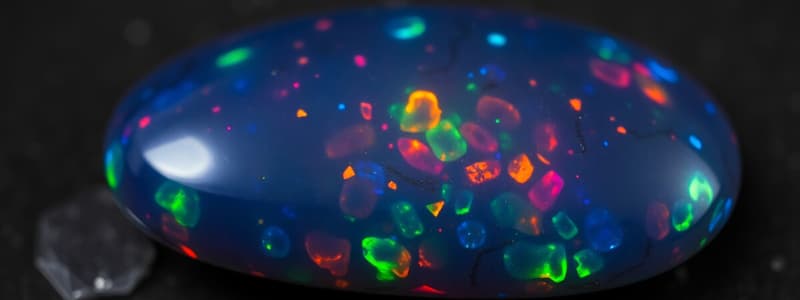Podcast
Questions and Answers
What is the primary component of Black Opal?
What is the primary component of Black Opal?
- Hydrated silica (correct)
- Calcium carbonate
- Magnesium silicate
- Aluminum oxide
Which location is renowned for its Black Opal deposits?
Which location is renowned for its Black Opal deposits?
- United States
- Coober Pedy
- Lightning Ridge (correct)
- Mexico
What factor primarily influences the value of Black Opal?
What factor primarily influences the value of Black Opal?
- Diameter of the stone
- Origin of the stone
- Color quality (correct)
- Market demand
How should Black Opal be cleaned to maintain its quality?
How should Black Opal be cleaned to maintain its quality?
What is a common treatment used to enhance Black Opal?
What is a common treatment used to enhance Black Opal?
Which of the following patterns is NOT a recognized pattern in Black Opal?
Which of the following patterns is NOT a recognized pattern in Black Opal?
What property of Black Opal is affected by its exposure to temperature changes?
What property of Black Opal is affected by its exposure to temperature changes?
Which of the following statements is true regarding Black Opal's historical significance?
Which of the following statements is true regarding Black Opal's historical significance?
How is Black Opal primarily formed?
How is Black Opal primarily formed?
What is the typical transparency of Black Opal?
What is the typical transparency of Black Opal?
Flashcards are hidden until you start studying
Study Notes
Characteristics of Black Opal
- Color: Predominantly dark body color, which can range from black to dark gray or blue.
- Play-of-Color: Displays vibrant flashes of color (reds, blues, greens, yellows) when viewed from different angles.
- Transparency: Usually opaque to semi-transparent.
- Composition: Made of hydrated silica (SiO2·nH2O), containing water in its structure.
Sources
- Location: Primarily found in Australia, with major deposits in:
- Lightning Ridge (most famous)
- Coober Pedy
- Andamooka
- Other sources include Mexico and some regions in the United States.
Formation
- Forms in opal-bearing sediments, often in volcanic rocks or sedimentary environments.
- Occurs over millions of years as silica and water solutions fill cracks and cavities.
Care and Maintenance
- Cleaning: Best cleaned with a soft cloth and mild soap; avoid ultrasonic cleaners.
- Storage: Should be stored away from direct sunlight and placed in a padded container to prevent scratching.
- Protection: Sensitive to temperature changes and chemicals; handle with care.
Value Factors
- Color Quality: More vibrant and diverse colors can increase value.
- Pattern: Unique patterns (harlequin, pinfire, etc.) positively impact desirability.
- Size: Larger stones generally have higher value.
- Origin: Stones from Lightning Ridge tend to command higher prices.
Uses
- Jewelry: Popular in rings, necklaces, earrings, and other adornments due to its beauty.
- Collectibles: Sought after by gem collectors and enthusiasts.
Historical Significance
- Considered the national gemstone of Australia.
- Has been part of Aboriginal Australian culture for thousands of years, often linked with various myths and stories.
Treatment and Enhancements
- Occasionally treated using processes like doublets (layering opal with a backing material) to enhance appearance and durability.
- Natural stones are more valuable than treated ones.
Black Opal Characteristics
- Black opals are known for their dark body color, ranging from black to dark gray or blue.
- They exhibit a captivating "play-of-color," showcasing vibrant flashes of reds, blues, greens, and yellows when viewed from different angles.
- Typically opaque to semi-transparent, meaning light cannot pass through them completely.
- Composed of hydrated silica (SiO2·nH2O), containing water within its structure.
Black Opal Sources
- Australia is the primary source of black opals, with significant deposits found in:
- Lightning Ridge (most renowned)
- Coober Pedy
- Andamooka
- Other sources include Mexico and certain regions of the United States.
Black Opal Formation
- Black opals form within opal-bearing sediments, typically found in volcanic rocks or sedimentary environments.
- Their formation is a gradual process that takes millions of years, where silica and water solutions fill cracks and cavities.
Black Opal Care and Maintenance
- Clean black opals gently with a soft cloth and mild soap; avoid ultrasonic cleaners, which can potentially damage them.
- Store them away from direct sunlight and in a padded container to prevent scratching.
- Protect black opals from extreme temperature changes and chemicals; handle them with care.
Black Opal Value Factors
- The vibrancy and diversity of colors play a significant role in determining value.
- Unique patterns, such as harlequin and pinfire, can significantly increase desirability.
- Larger black opals generally have higher value.
- Opals from Lightning Ridge, Australia, tend to command higher prices compared to those from other sources.
Black Opal Uses
- Black opals are widely used in jewelry, adorning rings, necklaces, earrings, and other pieces due to their beauty and rarity.
- They are also highly sought after by gem collectors and enthusiasts.
Black Opal Historical Significance
- Black opal is considered the national gemstone of Australia.
- It has been a part of Aboriginal Australian culture for thousands of years, often associated with various myths and stories.
Black Opal Treatment and Enhancements
- Black opals are sometimes treated to enhance their appearance and durability, often using doublets, which involve layering the opal with a backing material.
- However, natural, untreated black opals are generally more valuable than treated ones.
Studying That Suits You
Use AI to generate personalized quizzes and flashcards to suit your learning preferences.




